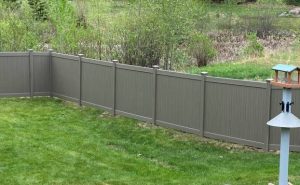 When it comes to finding a good Vinyl Fence specialist, you will need to look for a company that has a reputation for providing excellent service and quality work. Luckily, there are many great companies out there that provide these services, and you should have no trouble finding one that will be right for your needs. Some of these companies even offer free estimates for their services, making it easier to find out if they are a good fit for your home and budget. You may check out Kenosha Vinyl Fence to find the best vinyl fence specialist for you.
When it comes to finding a good Vinyl Fence specialist, you will need to look for a company that has a reputation for providing excellent service and quality work. Luckily, there are many great companies out there that provide these services, and you should have no trouble finding one that will be right for your needs. Some of these companies even offer free estimates for their services, making it easier to find out if they are a good fit for your home and budget. You may check out Kenosha Vinyl Fence to find the best vinyl fence specialist for you.
A vinyl fence is a great option for homeowners who want to add privacy and security to their property without having to deal with a lot of maintenance. Unlike wood fences, vinyl fences don’t require regular staining and painting and they won’t chip or fade over time. Additionally, they are highly resistant to water damage and don’t rust or corrode like metal fences can. Additionally, vinyl fences are fire retardant and won’t splinter like wood fencing can, making them safer for children and pets.
Another benefit of vinyl fences is that they are easy to clean. A simple rinse with the garden hose is usually enough to keep them looking new, and you can also use a pressure washer for more thorough cleaning. Additionally, because vinyl is nonporous, it won’t grow mildew as easily as a wooden fence can. This can be a problem because mildew can become mold, which can be dangerous to your family’s health.
Additionally, the color options for vinyl fences are virtually endless. There are neutral colors, such as white, tan, and gray, and there are also bolder choices, such as green, blue, and red. Vinyl fences can also be textured to look like other materials, including natural wood and stucco.
The material used to make vinyl is polyvinyl chloride, which can be derived from two simple ingredients: petroleum and salt (i.e. sodium chloride). The compound is produced through a process known as extrusion, which involves pressing the vinyl resin into a heated barrel and die using large screws. There are two basic methods for doing this: monoextrusion and co-extrusion. Monoextrusion is the older method and uses a single stream of vinyl to feed into a die, while co-extrusion allows for different formulations of additives to be fed into each of the two layers that make up the finished product.
Vinyl fences are typically more expensive than other fencing materials, but they last longer and require fewer repairs than traditional wood fences. They are also more attractive, which can help to increase the value of your home and improve its curb appeal. In addition, they can be installed in many different areas, including around the pool, garden, and backyard.
While the initial cost of a vinyl fence is higher than that of other fencing materials, it is still an affordable option for most homeowners. Moreover, most manufacturers provide a lifetime warranty on their products, which can help to alleviate the initial financial burden.